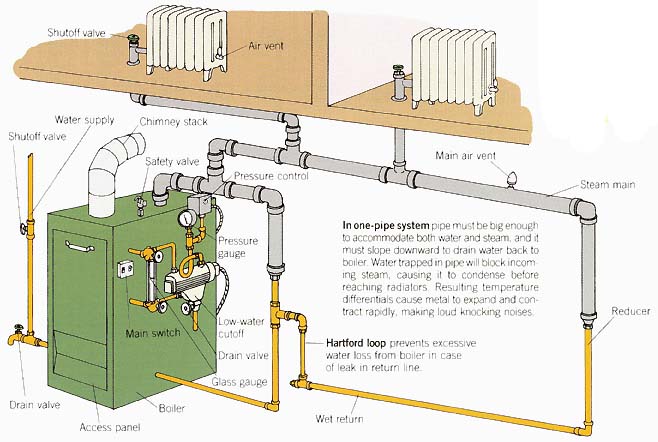How They Work
Steam systems heat water in a boiler until it vapor izes and rises through pipes to radiators and convectors that radiate heat into the room. When the steam hits the cooler radiator surfaces, it condenses and the water runs back to the boiler. As steam rises in the pipes, quick- release air vents let air escape from the main steam lines and individual radiators. As the steam advances, pres sure forces the air out of the vents. (Change a vent that spits or drips water, leaks steam or fails to open.)
Steam systems come in two basic types. In a two-pipe system, the steam flows through one set of pipes and the condensate, water, returns through another. In a one-pipe system (like the one shown below), the steam and water travel through the same pipe in opposite directions.
When water is heated to steam, pressure builds in the boiler. Check the pressure gauge just after the boiler switches off. If it's far above the recommended pressure setting (generally 2 psi or less), have the boiler pressure control replaced immediately. Boilers also have a pressure safety valve that will open before an unsafe pressure level is reached. Test yours regularly. Another safety feature: The low-water cutoff turns off the burner if the water in the boiler falls below a safe level. Release about a quart of water from the low- water cutoff once a week. Do this while the burner is operating to make sure that it shuts off. Be careful, though, the water is very hot.
(click here or image below for clearer, larger version of image)
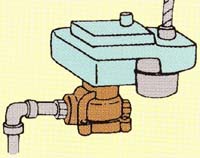
Automatic water feeder: is on some boilers; replace it if water level falls and boiler doesn't refill.
continued....

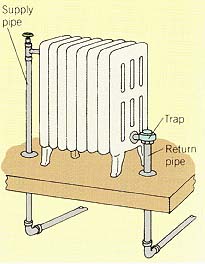
Steam Trap: On some two-pipe steam systems, each radiator is fitted with a steam trap (instead of an air vent). The trap holds steam inside the radiator until it gives up all its heat. If return pipes feel very hot or if steam comes out of main air vent in great quantities, one or more traps may be defective; have them checked. If a trap leaks, steam will pass directly into return pipe and be wasted; replace leaky trap.
Maintenance
Steam systems operate at high temperature. Regular maintenance improves efficiency and , more importantly, ensures your family’s safety. Have the system checked annually by a service person. If the system operates poorly, call a professional. Malfunctions can be difficult to pinpoint without special equipment.
Radiators require a free flow of air to work efficiently. Don’t block them with furniture, and cover them only with special vented covers. Vacuum radiators often. Inspect exposed piping runs for breaks or gaps in insulation, but be careful, as some old systems used asbestos. You can per form some simple maintenance steps by following the procedures shown here.

Above: Check air vents for clogging by listening for a hissing sound and checking radiator for heat. If valve is adjustable, open fully when checking. Replace clogged vent with one of the same size. If a room overheats, add a thermostatic valve to radiator.
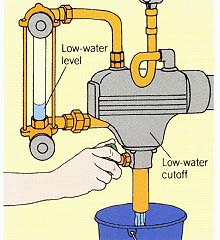
Above:
Flush low-water cutoff once a week in heating
season to prevent sediment buildup. Turn down the thermostat, put
a bucket under the pipe, open the valve and let water run until
it’s clear. Be careful; water will be hot. Close valve; refill
boiler to proper level.

Above:
Check water level when boiler is off, every 10
to 14 days in cold weather. If water level is less than halfway up
glass gauge, open water-supply valve after the boiler has been shut
off for an hour or so, until water reaches the proper level.

Above: Check safety valve once a year. With boiler running,
pull up lever and let small amount of steam escape. Watch that valve
reseals and doesn't leak. If it sticks or is clogged, shut off power and have the valve replaced.
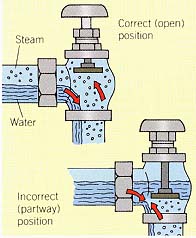
Above:
Prevent knocking in a one-pipe system by opening
or closing valves fully. Because steam enters and water leaves
through same valve, a half-closed valve mixes water and steam,
causing knocking at the valve.

Above: Stopping Knocks: In one-pipe radiator, tip
end opposite pipe a bit higher to keep water from collecting at bottom and blocking incoming steam. If radiator has height-adjustment bolts
in legs, simply loosen them; other wise slide shims or checkers under
legs.

Above:
Increasing Efficiency: Increase radiator efficiency
by sliding a reflector between it and outside wall to reflect heat
back into room and keep it from being lost to outside wall. You
can buy insulated reflectors or make them with corrugated cardboard and aluminum foil.
